2025 |
||
| 33. | 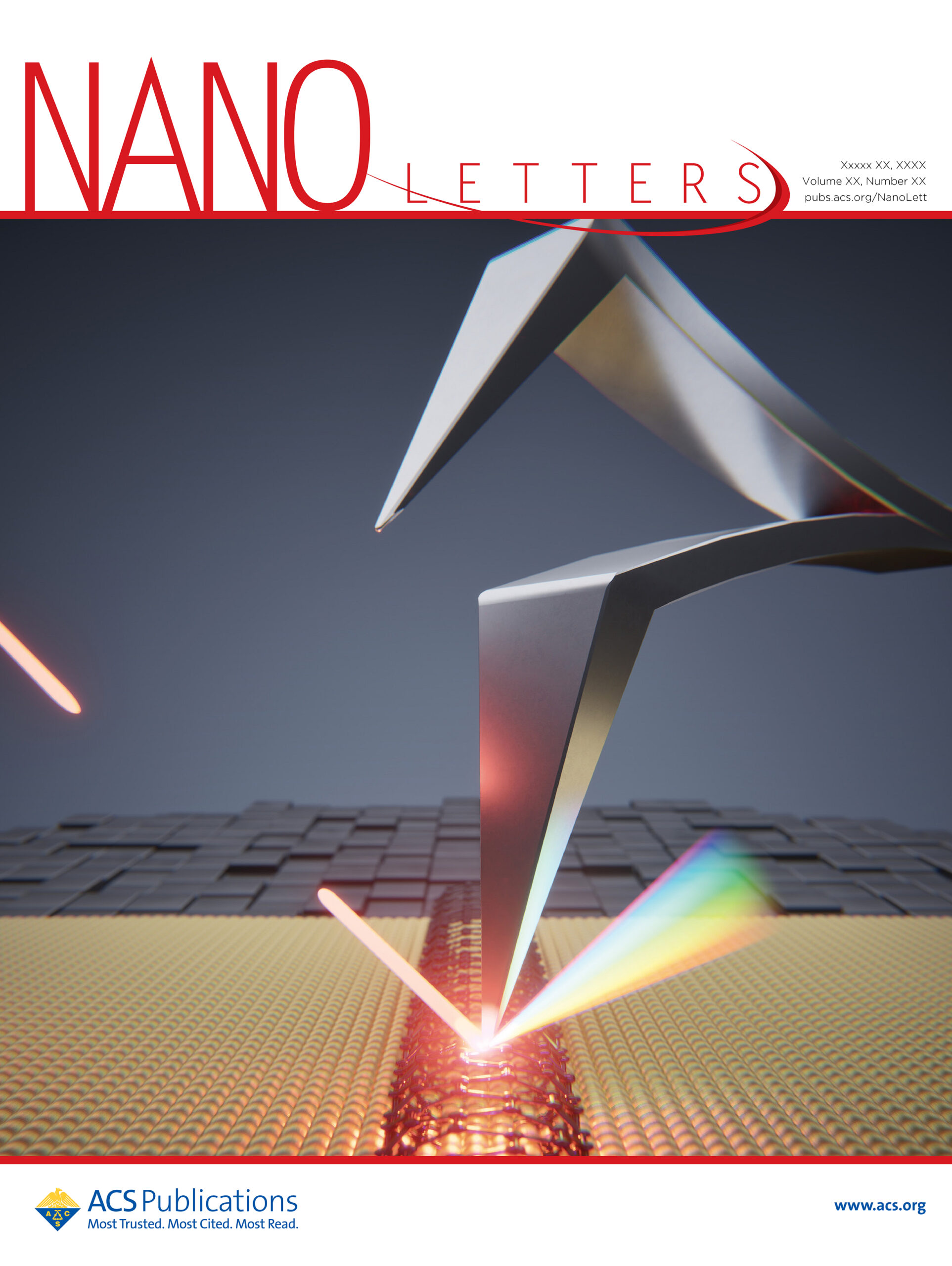 | M. G. Ruppert; B. S. Routley; L. R. McCourt; Y. K. Yong; A. J. Fleming Modulated-Illumination Intermittent-Contact Tip-Enhanced Raman Spectroscopy Journal Article In: ACS Nano Letters, 2025. Abstract | Links | BibTeX | Tags: AFM, TERS @article{Ruppert2025,This article presents a proof-of-concept for a new imaging method that combines tip-enhanced Raman spectroscopy with intermittent-contact atomic force microscopy to provide simultaneous nanometer-scale mechanical imaging with chemical contrast. The foremost difference from a standard tip-enhanced Raman microscope is the Raman illumination, which is modulated by the cantilever drive signal so that illumination is only active when the tip is close to the surface. This approach significantly reduces contact forces and thermal damage due to constant illumination while simultaneously reducing background Raman signals. Near-field optical and dynamic cantilever simulations highlight the effect of the imaging parameters on the tip–sample force and the evanescent field enhancement. The experimental images obtained with this new imaging method demonstrate a lateral resolution sufficient to identify single-walled carbon nanotube bundles with a full width at half-maximum of 20 nm. |
2024 |
||
| 32. | 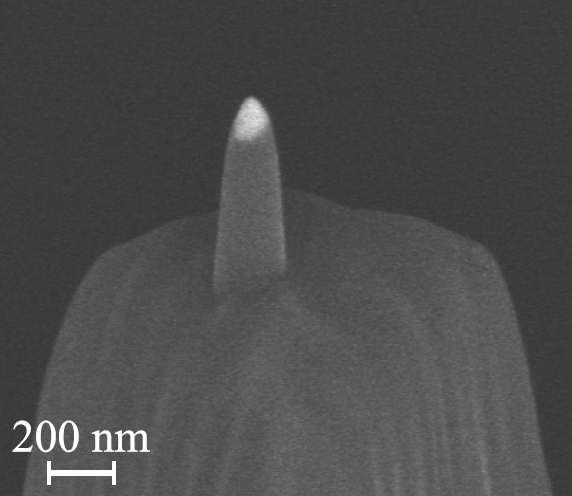 | L. R. McCourt; B. S. Routley; M. G. Ruppert; A. J. Fleming Feasibility of gold nanocones for collocated tip-enhanced Raman spectroscopy and atomic force microscope imaging Journal Article Forthcoming In: Journal of Raman Spectroscopy, Forthcoming, ISSN: 1097-4555. Abstract | Links | BibTeX | Tags: AFM, Cantilever, Optics @article{J23a,Microcantilever probes for tip-enhanced Raman spectroscopy (TERS) have a grainy metal coating that may exhibit multiple plasmon hotspots near the tip apex, which may compromise spatial resolution and introduce imaging artefacts. It is also possible that the optical hotspot may not occur at the mechanical apex, which introduces an offset between TERS and atomic force microscope maps. In this article, a gold nanocone TERS probe is designed and fabricated for 638 nm excitation. The imaging performance is compared to grainy probes by analysing high-resolution TERS cross-sections of single-walled carbon nanotubes. Compared to the tested conventional TERS probes, the nanocone probe exhibited a narrow spot diameter, comparable optical contrast, artefact-free images, and collocation of TERS and atomic force microscope topographic maps. The spot diameter was 12.5 nm and 19 nm with 638 nm and 785 nm excitation, respectively. These results were acquired using a single gold nanocone probe to experimentally confirm feasibility. Future work will include automating the fabrication process and statistical analysis of many probes. |
2022 |
||
| 31. | 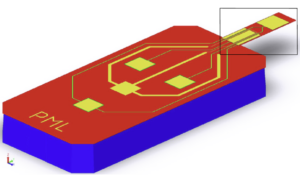 | N. F. S. de Bem; M. G. Ruppert; A. J. Fleming; Y. K. Yong In: Sensors and Actuators A: Physical, vol. 338, pp. 113496, 2022, ISSN: 0924-4247, (This work was supported by the Australian Research Council Discovery Project DP170101813). Abstract | Links | BibTeX | Tags: AFM, DP170101813 @article{J22a,The use of integrated on-chip actuation simplifies the identification of a cantilever resonance, can improve imaging speed, and enables the use of smaller cantilevers, which is required for low-force imaging at high speed. This article describes a cantilever with on-chip actuation and novel dual-sensing capabilities for AFM. The dual-sensing configuration allows for tip displacement and tip force to be measured simultaneously. A mathematical model is developed and validated with finite element analysis. A physical prototype is presented, and its calibration and validation are presented. The cantilever is optimized for use in off-resonance tapping modes. Experimental results demonstrate an agreement between the on-chip sensors and external force and displacement measurements. |
| 30. | 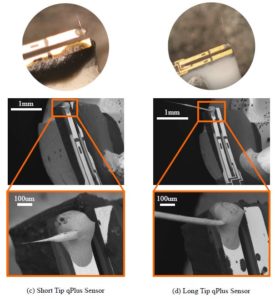 | M. G. Ruppert; D. Martin-Jimenez; Y. K. Yong; A. Ihle; A. Schirmeisen; A. J. Fleming; D. Ebeling Experimental Analysis of Tip Vibrations at Higher Eigenmodes of QPlus Sensors for Atomic Force Microscopy Journal Article In: Nanotechnology, vol. 33, iss. 18, pp. 185503, 2022, ISSN: 1361-6528, (This work was supported in part by the Australian Research Council Discovery Project DP170101813). Abstract | Links | BibTeX | Tags: Actuator, AFM, Cantilever, DP170101813, Multifrequency AFM, piezoelectric @article{Ruppert2022,QPlus sensors are non-contact atomic force microscope probes constructed from a quartz tuning fork and a tungsten wire with an electrochemically etched tip. These probes are self-sensing and offer an atomic-scale spatial resolution. Therefore, qPlus sensors are routinely used to visualize the chemical structure of adsorbed organic molecules via the so-called bond imaging technique. This is achieved by functionalizing the AFM tip with a single CO molecule and exciting the sensor at the first vertical cantilever resonance mode. Recent work using higher-order resonance modes has also resolved the chemical structure of single organic molecules. However, in these experiments, the image contrast can differ significantly from the conventional bond imaging contrast, which was suspected to be caused by unknown vibrations of the tip. This work investigates the source of these artefacts by using a combination of mechanical simulation and laser vibrometry to characterize a range of sensors with different tip wire geometries. The results show that increased tip mass and length cause increased torsional rotation of the tuning fork beam due to the off-center mounting of the tip wire, and increased flexural vibration of the tip. These undesirable motions cause lateral deflection of the probe tip as it approaches the sample, which is rationalized to be the cause of the different image contrast. The results also provide a guide for future probe development to reduce these issues. |
2021 |
||
| 29. | 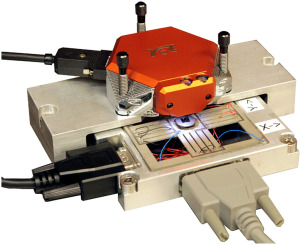 | M. Omidbeike; S. I. Moore; Y. K. Yong; A. J. Fleming Five-Axis Bimorph Monolithic Nanopositioning Stage: Design, Modeling, and Characterization Journal Article In: Sensors and Actuators A: Physical, vol. 332, iss. 1, 2021, ISSN: 0924-4247. Abstract | Links | BibTeX | Tags: AFM, Nanopositioning, piezoelectric @article{Omidbeike2021,The article describes the design and modeling of a five-axis monolithic nanopositioning stage constructed from a bimorph piezoelectric sheet. Six-axis motion is also possible but requires 16 amplifier channels rather than 8. The nanopositioner is ultra low profile with a thickness of 1 mm. Analytical modeling and finite-element-analysis accurately predict the experimental performance. The stage was conservatively driven with 33% of the maximum voltage, which resulted in an X and Y travel range of 6.22 μm and 5.27 μm respectively; a Z travel range of 26.5 μm; and a rotational motion of 600 μrad and 884 μrad about the X and Y axis respectively. The first resonance frequency occurs at 883 Hz in the Z axis. Experimental atomic force microscopy is performed using the proposed device as a sample scanner. |
| 28. | 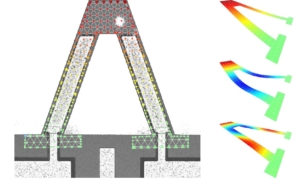 | M. G. Ruppert; N. F. S. de Bem; A. J. Fleming; Y. K. Yong Characterization of Active Microcantilevers Using Laser Doppler Vibrometry Book Chapter In: Vibration Engineering for a Sustainable Future , Chapter 45, Springer, 2021, ISBN: 978-3-030-48153-7, (This work was supported by the Australian Research Council Discovery Project DP170101813). Abstract | Links | BibTeX | Tags: AFM, Cantilever, DP170101813, MEMS, Piezoelectric Transducers and Drives, Smart Structures @inbook{Ruppert2021b,Active atomic force microscope cantilevers with on-chip actuation and sensing provide several advantages over passive cantilevers which rely on piezoacoustic base-excitation and the optical beam deflection measurement. Most importantly, these cantilevers provide clean frequency responses, the possibility of down-scaling and parallelization to cantilever arrays as well as the absence of optical interferences. In this paper, we demonstrate the analysis and calibration steps for three active cantilever geometries with integrated piezoelectric actuation. For this purpose, laser Doppler vibrometry (LDV) is used to experimentally obtain the deflection mode shapes of the first three eigenmodes, calibrate actuation gains, and to determine the dynamic modal stiffnesses using the Brownian spectrum of the cantilever. The experimental values are compared with finite element simulations. |
| 27. | 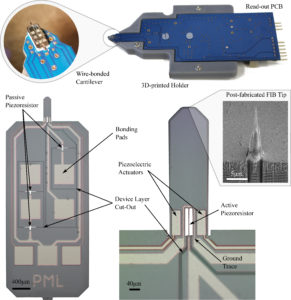 | M. G. Ruppert; A. J. Fleming; Y. K. Yong Active atomic force microscope cantilevers with integrated device layer piezoresistive sensors Journal Article In: Sensors & Actuators: A. Physical, vol. 319, pp. 112519, 2021, ISSN: 0924-4247, (This work was supported by the Australian Research Council Discovery Project DP170101813). Abstract | Links | BibTeX | Tags: AFM, Cantilever, DP170101813, MEMS, Sensors, Smart Structures @article{Ruppert2021,Active atomic force microscope cantilevers with on-chip actuation and sensing provide several advantages over passive cantilevers which rely on piezoacoustic base-excitation and optical beam deflection measurement. Active microcantilevers exhibit a clean frequency response, provide a path-way to miniturization and parallelization and avoid the need for optical alignment. However, active microcantilevers are presently limited by the feedthrough between actuators and sensors, and by the cost associated with custom microfabrication. In this work, we propose a hybrid cantilever design with integrated piezoelectric actuators and a piezoresistive sensor fabricated from the silicon device layer without requiring an additional doping step. As a result, the design can be fabricated using a commercial five-mask microelectromechanical systems fabrication process. The theoretical piezoresistor sensitivity is compared with finite element simulations and experimental results obtained from a prototype device. The proposed approach is demonstrated to be a promising alternative to conventional microcantilever actuation and deflection sensing |
2020 |
||
| 26. | 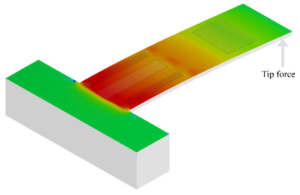 | N. F. S. de Bem; M. G. Ruppert; Y. K. Yong; A. J. Fleming Integrated force and displacement sensing in active microcantilevers for off-resonance tapping mode atomic force microscopy Proceedings Article In: International Conference on Manipulation, Automation and Robotics at Small Scales (MARSS), pp. 1-6, 2020, (This work was supported by the Australian Research Council Discovery Project DP170101813). Abstract | Links | BibTeX | Tags: AFM, DP170101813, MEMS, SPM @inproceedings{C20c,Integrated on-chip actuation and sensing in microcantilevers for atomic force microscopy (AFM) allows faster scanning speeds, cleaner frequency responses and smaller cantilevers. However, a single integrated sensor suffers from crosscoupling between displacements originating from tip-sample forces and direct actuation. This paper addresses this issue by presenting a novel microcantilever with on-chip actuation and integrated dual sensing for AFM with application to offresonance tapping modes in AFM. The proposed system is able to measure tip force and deflection simultaneously. A mathematical model is developed for a rectangular cantilever to describe the system and is validated with finite element analysis. |
| 25. | 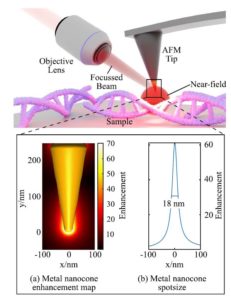 | L. McCourt; M. G. Ruppert; B. S. Routley; S. Indirathankam; A. J. Fleming A comparison of gold and silver nanocones and geometry optimisation for tip-enhanced microscopy Journal Article In: Journal of Raman Spectroscopy, vol. 51, iss. 11, pp. 2208-2216, 2020. Abstract | Links | BibTeX | Tags: AFM, Cantilever, MEMS, Optics, SPM @article{McCourt2020,In this article, boundary element method simulations are used to optimise the geometry of silver and gold nanocone probes to maximise the localised electric field enhancement and tune the near-field resonance wavelength. These objectives are expected to maximise the sensitivity of tip-enhanced Raman microscopes. Similar studies have used limited parameter sets or used a performance metric other than localised electric field enhancement. In this article, the optical responses for a range of nanocone geometries are simulated for excitation wavelengths ranging from 400 to 1000 nm. Performance is evaluated by measuring the electric field enhancement at the sample surface with a resonant illumination wavelength. These results are then used to determine empirical models and derive optimal nanocone geometries for a particular illumination wavelength and tip material. This article concludes that gold nanocones are expected to provide similar performance to silver nanocones at red and nearinfrared wavelengths, which is consistent with other results in the literature. In this article, 633 nm is determined to be the shortest usable illumination wavelength for gold nanocones. Below this limit, silver nanocones will provide superior enhancement. The use of gold nanocone probes is expected to dramatically improve probe lifetime, which is currently measured in hours for silver coated probes. Furthermore, the elimination of passivation coatings is expected to enable smaller probe radii and improved topographical resolution. |
| 24. | 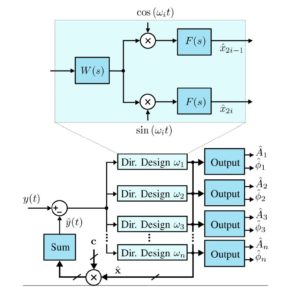 | M. G. Ruppert; D. M. Harcombe; A. J. Fleming Traditional and Novel Demodulators for Multifrequency Atomic Force Microscopy Conference 8th Multifrequency AFM Conference, Madrid, Spain, 2020. Abstract | BibTeX | Tags: AFM, Demodulation, Multifrequency AFM @conference{Ruppert2020b,A number of multifrequency atomic force microscopy (MF-AFM) methods make use of the excitation and detection of higher harmonics of the fundamental frequency, higher flexural eigenmodes or intermodulation products generated by the non-linear tip-sample force [1]. Schematically, these methods are depicted in Figure 1(a) where the main difference is the resulting spacing and amplitude of the frequency components in the generated spectrum shown in Figure 1(b). Regardless of which particular MF-AFM method is employed, each requires a demodulator to obtain amplitude and phase to form observables for the characterization of nanomechanical sample information. Since high-speed non-synchronous demodulators such as the peak-hold method, peak detector and RMS-to-DC converter are incompatible with MF-AFM [2], there is a need for high-bandwidth demodulation techniques capable of estimating multiple frequencies at once while maintaining robustness against unwanted frequency components [3]. In this talk, the performance of traditional and recently proposed demodulators for multifrequency atomic force microscopy is assessed experimentally. The compared methods include the lock-in amplifier, coherent demodulator, Kalman filter, Lyapunov filter, and direct-design demodulator. Each method is implemented on a field-programmable gate array (FPGA) with a sampling rate of 1.5 MHz. The metrics for comparison include implementation complexity, the sensitivity to other frequency components and the magnitude of demodulation artifacts for a range of demodulator bandwidths. Performance differences are demonstrated through higher harmonic atomic force microscopy imaging. |
| 23. | 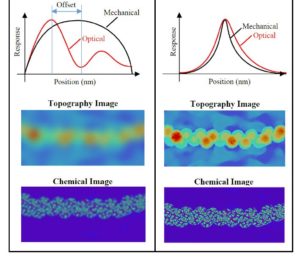 | A. J. Fleming; M. G. Ruppert; B. S. Routley; L. McCourt Overcoming the Limitations of Tip Enhanced Raman Spectroscopy with Intermittent Contact AFM Conference 8th Multifrequency AFM Conference, Madrid, Spain, 2020. Abstract | BibTeX | Tags: AFM, Multifrequency AFM, Optics, SPM @conference{Fleming2020,Tip enhanced Raman spectroscopy (TERS) is a promising technique for mapping the chemical composition of surfaces with molecular scale. However, current TERS methods are limited by a number of issues including high tip-sample forces, high laser power, low topographical resolution, and short probe lifetime. As a result, TERS methods are best suited to robust samples that can tolerate high optical intensity. To overcome these issues and extend the application of TERS to delicate samples, a number of new probes andimaging modes are in development at the University of Newcastle. This talk will provide an overview of these methods and present preliminary results, including new methods for optical probe optimization and fabrication, and a new dynamic-mode AFM method to reduce contact forces and applied laser power. |
| 22. | 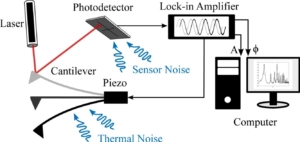 | M. G. Ruppert; N. J. Bartlett; Y. K. Yong; A. J. Fleming Amplitude Noise Spectrum of a Lock-in Amplifier: Application to Microcantilever Noise Measurements Journal Article In: Sensors and Actuators A: Physical, vol. 312, pp. 112092, 2020, (This work was supported by the Australian Research Council Discovery Project DP170101813). Abstract | Links | BibTeX | Tags: AFM, Cantilever, Demodulation, DP170101813, MEMS, System Identification @article{Ruppert2020,The lock-in amplifier is a crucial component in many applications requiring high-resolution displacement sensing; it's purpose is to estimate the amplitude and phase of a periodic signal, potentially corrupted by noise, at a frequency determined by a reference signal. Where the noise can be approximated by a stationary Gaussian process, such as thermal force noise and electronic sensor noise, this article derives the amplitude noise spectral density of the lock-in-amplifier output. The proposed method is demonstrated by predicting the demodulated noise spectrum of a microcantilever for dynamic-mode atomic force microscopy to determine the cantilever on-resonance thermal noise, the cantilever tracking bandwidth and the electronic noise floor. The estimates are shown to closely match experimental results over a wide range of operating conditions. |
| 21. | 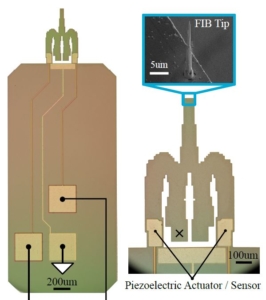 | S. I. Moore; M. G. Ruppert; Y. K. Yong AFM Cantilever Design for Multimode Q Control: Arbitrary Placement of Higher-Order Modes Journal Article In: IEEE/ASME Transactions on Mechatronics, pp. 1-6, 2020, (This work was supported by the Australian Research Council Discovery Project DP170101813). Abstract | Links | BibTeX | Tags: AFM, Cantilever, DP170101813, MEMS, Multifrequency AFM, Smart Structures, SPM, Vibration Control @article{Moore2020,In the fast growing field of multifrequency atomic force microscopy (AFM), the benefits of using higher-order modes has been extensively reported on. However, higher modes of AFM cantilevers are difficult to instrument and Q control is challenging owing to their high frequency nature. At these high frequencies, the latencies in the computations and analog conversions of digital signal processing platforms become significant and limit the effective bandwidth of digital feedback controller implementations. To address this issue, this article presents a novel cantilever design for which the first five modes are placed within a 200 kHz bandwidth. The proposed cantilever is designed using a structural optimization routine. The close spacing and low mechanical bandwidth of the resulting cantilever allows for the implementation of Q controllers for all five modes using a standard FPGA development board for bimodal AFM and imaging on higher-order modes. |
| 20. | 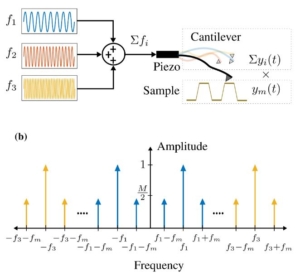 | D. M. Harcombe; M. G. Ruppert; A. J. Fleming A review of demodulation techniques for multifrequency atomic force microscopy Journal Article In: Beilstein Journal of Nanotechnology, vol. 11, pp. 76-97, 2020, ISSN: 21904286. Abstract | Links | BibTeX | Tags: AFM, Demodulation, Multifrequency AFM, SPM @article{Harcombe2020,This article compares the performance of traditional and recently proposed demodulators for multifrequency atomic force microscopy. The compared methods include the lock-in amplifier, coherent demodulator, Kalman filter, Lyapunov filter, and direct-design demodulator. Each method is implemented on a field-programmable gate array (FPGA) with a sampling rate of 1.5 MHz. The metrics for comparison include the sensitivity to other frequency components and the magnitude of demodulation artifacts for a range of demodulator bandwidths. Performance differences are demonstrated through higher harmonic atomic force microscopy imaging. |
2019 |
||
| 19. | 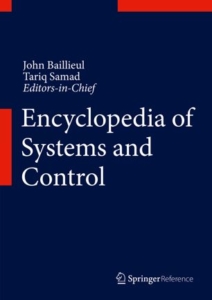 | M. G. Ruppert; S. O. R. Moheimani Dynamics and Control of Active Microcantilevers Book Chapter In: Baillieul, John; Samad, Tariq (Ed.): Encyclopedia of Systems and Control, vol. 2, Springer London, 2019, ISBN: 978-1-4471-5102-9. Abstract | Links | BibTeX | Tags: AFM, Cantilever, MEMS, Multifrequency AFM, Piezoelectric Transducers and Drives, Smart Structures, Vibration Control @inbook{Ruppert2019b,The microcantilever is a key precision mechatronic component of many technologies for characterization and manipulation of matter at the nanoscale, particularly in the atomic force microscope. When a cantilever is operated in a regime that requires the direct excitation and measurement of its resonance frequencies, appropriate instrumentation and control is crucial for high-performance operation. In this entry, we discuss integrated cantilever actuation and present the cantilever transfer function model and its properties. As a result of using these active cantilevers, the ability to control the quality factor in order to manipulate the cantilever tracking bandwidth is demonstrated. |
| 18. |  | K. Wang; M. G. Ruppert; C. Manzie; D. Nesic; Y. K. Yong Scan Rate Adaptation for AFM Imaging Based on Performance Metric Optimisation Journal Article In: IEEE/ASME Transactions on Mechatronics, 2019, (early access). Abstract | Links | BibTeX | Tags: AFM, Nanopositioning, Scan Pattern, SPM, Tracking Control @article{Wang2019b,Constant-force contact-mode atomic force microscopy (AFM) relies on a feedback control system to regulate the tip-sample interaction during imaging. Due to limitations in actuators and control, the bandwidth of the regulation system is typically small. Therefore, the scan rate is usually limited in order to guarantee a desirable image quality for a constant-rate scan. By adapting the scan rate online, further performance improvement is possible, and the conditions to this improvement has been explored qualitatively in a previous study for a wide class of possible scan patterns. In this paper, a quantitative assessment of the previously proposed adaptive scan scheme is investigated through experiments that explore the impact of various degrees of freedom in the algorithm. Further modifications to the existing scheme are proposed and shown to improve the closed-loop performance. The flexibility of the proposed approach is further demonstrated by applying the algorithm to tapping-mode AFM. |
| 17. | 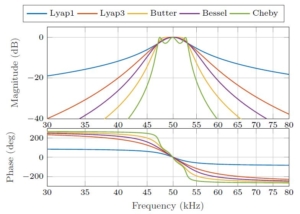 | M. R. P. Ragazzon; S. Messineo; J. T. Gravdahl; D. M. Harcombe; M. G. Ruppert Generalized Lyapunov Demodulator for Amplitude and Phase Estimation by the Internal Model Principle Proceedings Article In: 8th IFAC Symposium on Mechatronic Systems, 2019, (accepted for publication). Abstract | BibTeX | Tags: AFM, Cantilever, Demodulation, SPM @inproceedings{Ragazzon2019,Effective demodulation of amplitude and phase is a requirement in a wide array of applications. Recent efforts have increased the demodulation performance, in particular, the Lyapunov demodulator allows bandwidths up to the carrier frequency of the signal. However, being inherently restricted to a single order filtering of the input signal, signal components outside its passband are not sufficiently attenuated for all applications, such as in multifrequency atomic force microscopy. In this article, the structure of the Lyapunov demodulator is transformed to an equivalent form, taking advantage of the internal model representation of the sinusoid to be tracked. A generalization of this formulation allows the application of standard filtering techniques in order to shape the characteristics of the demodulator, while retaining the perfect tracking condition provided by the internal model. Guidelines for the filter design are provided in order to achieve the desired characteristics, such as filtering order, tracking bandwidth, and transient performance. The resulting generalized Lyapunov demodulator structure is highly flexible, allows for direct employment of any standard filter type, is computationally simple, and easy to implement requiring only a bandpass filter, a single integrator, and two nonlinear transformations. Numerical results demonstrate the effectiveness of the approach, and provide a comparison of the various filters considered. |
| 16. | L. McCourt; B. S. Routley; M. G. Ruppert; A. J. Fleming Resolution and Enhancement of Probes for Tip Enhanced Raman Spectroscopy Conference International Conference on Nanophotonics and Micro/Nano Optics (NANOP), Munich, Germany, 2019. Abstract | BibTeX | Tags: AFM, Cantilever, Lithography @conference{McCourt2019,Two photon apertureless nearfield lithography allows sub diffraction limited features for integrated circuit production. It involves exciting surface plasmons on a metallic atomic force microscopy probe, which generates an enhancement of the localised electric field, exposing a photoresist. Costing less than extreme ultra violet lithography, and reducing exposure from scattered light compared to one photon nearfield lithography, this technique is suited for device prototyping or low volume production. The work here considers the material and geometry of an ideal AFM probe in terms of resolution (producing the smallest features) and electric field enhancement. | |
| 15. | 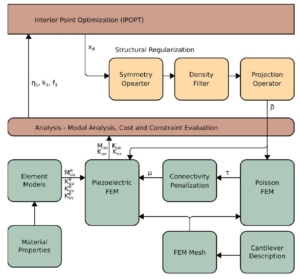 | S. I. Moore; M. G. Ruppert; Y. K. Yong An optimization framework for the design of piezoelectric AFM cantilevers Journal Article In: Precision Engineering, vol. 60, pp. 130-142, 2019, (This work was supported by the Australian Research Council Discovery Project DP170101813). Abstract | Links | BibTeX | Tags: AFM, Cantilever, DP170101813, MEMS, Piezoelectric Transducers and Drives, Smart Structures, SPM @article{Moore2019c,To facilitate further miniaturization of atomic force microscopy (AFM) cantilevers and to eliminate the standard optical beam deflection sensor, integrated piezoelectric actuation and sensing on the chip level is a promising option. This article presents a topology optimization method for dynamic mode AFM cantilevers that maximizes the sensitivity of an integrated piezoelectric sensor under stiffness and resonance frequency constraints. Included in the formulation is a new material model C-SIMP (connectivity and solid isotropic material with penalization) that extends the SIMP model to explicitly include the penalization of unconnected structures. Example cantilever designs demonstrate the potential of the topology optimization method. The results show, firstly, the C-SIMP material model significantly reduces connectivity issues and, secondly, arbitrary cantilever topologies can produce increases in sensor sensitivity or resonance frequency compared to a rectangular topology. |
| 14. | 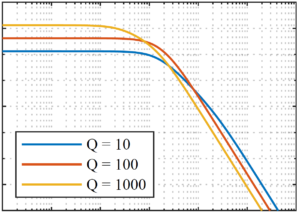 | D. M. Harcombe; M. G. Ruppert; A. J. Fleming Modeling and Noise Analysis of a Microcantilever-based Mass Sensor Proceedings Article In: Int. Conference on Manipulation, Automation and Robotics at Small Scales (MARSS), Helsinki, Finland, 2019, ISSN: 978-1-7281-0948-0. Abstract | Links | BibTeX | Tags: AFM, Cantilever, MEMS, Sensors, Smart Structures @inproceedings{Harcombe2019,Nanomechanical devices have the potential for practical applications as mass sensors. In microcantilever based sensing, resonance frequency shifts are tracked by a phase-locked loop (PLL) in-order to monitor mass adsorption. A major challenge in minimizing the mass detection limit comes from the noise present in the system due to thermal, sensor and oscillator noise. There is numerical difficulty in simulating PLLs, as both low frequency phase estimates and high frequency mixing products need to be captured resulting in a stiff problem. By using linear system-theoretic modeling an in-depth analysis of the system is able to be conducted overcoming this issue. This provides insight into individual noise source propagation, dominant noise sources and possible ways to reduce their effects. The developed model is verified in simulation against the non-linear PLL, with each achieving low picogram sensitivity for a 100 Hz loop bandwidth and realistically modeled noise sources. |
| 13. | 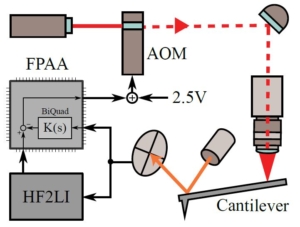 | M. G. Ruppert; B. S. Routley; A. J. Fleming; Y. K. Yong; G. E. Fantner Model-based Q Factor Control for Photothermally Excited Microcantilevers Proceedings Article In: Int. Conference on Manipulation, Automation and Robotics at Small Scales (MARSS), Helsinki, Finland, 2019, ISSN: 978-1-7281-0948-0, (This work was supported by the Australian Research Council Discovery Project DP170101813). Abstract | Links | BibTeX | Tags: AFM, DP170101813, Multifrequency AFM, Sensors, Smart Structures, SPM, Vibration Control @inproceedings{Ruppert2019,Photothermal excitation of the cantilever for dynamic atomic force microscopy (AFM) modes is an attractive actuation method as it provides clean cantilever actuation leading to well-defined frequency responses. Unlike conventional piezo-acoustic excitation of the cantilever, it allows for model-based quality (Q) factor control in order to increase the cantilever tracking bandwidth for tapping-mode AFM or to reduce resonant ringing for high-speed photothermal offresonance tapping (PORT) in ambient conditions. In this work, we present system identification, controller design and experimental results on controlling the Q factor of a photothermally driven cantilever. The work is expected to lay the groundwork for future implementations for high-speed PORT imaging in ambient conditions. |
| 12. | 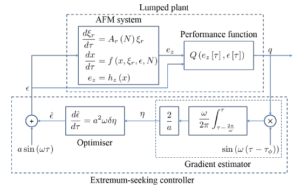 | K. Wang; M. G. Ruppert; C. Manzie; D. Nesic; Y. K. Yong Adaptive Scan for Atomic Force Microscopy Based on Online Optimisation: Theory and Experiment Journal Article In: IEEE Transactions on Control System Technology, 2019, (accepted for publication). Abstract | Links | BibTeX | Tags: AFM, Nanopositioning, SPM, System Identification, Tracking Control @article{Wang2019,A major challenge in Atomic Force Microscopy (AFM) is to reduce the scan duration while retaining the image quality. Conventionally, the scan rate is restricted to a sufficiently small value in order to ensure a desirable image quality as well as a safe tip-sample contact force. This usually results in a conservative scan rate for samples that have a large variation in aspect ratio and/or for scan patterns that have a varying linear velocity. In this paper, an adaptive scan scheme is proposed to alleviate this problem. A scan line-based performance metric balancing both imaging speed and accuracy is proposed, and the scan rate is adapted such that the metric is optimised online in the presence of aspect ratio and/or linear velocity variations. The online optimisation is achieved using an extremum-seeking (ES) approach, and a semi-global practical asymptotic stability (SGPAS) result is shown for the overall system. Finally, the proposed scheme is demonstrated via both simulation and experiment. |
| 11. | 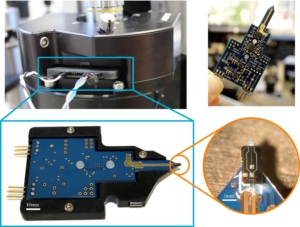 | M. G. Ruppert; S. I. Moore; M. Zawierta; A. J. Fleming; G. Putrino; Y. K. Yong Multimodal atomic force microscopy with optimized higher eigenmode sensitivity using on-chip piezoelectric actuation and sensing Journal Article In: Nanotechnology, vol. 30, no. 8, pp. 085503, 2019, (This work was supported by the Australian Research Council Discovery Project DP170101813). Abstract | Links | BibTeX | Tags: AFM, Cantilever, DP170101813, MEMS, Multifrequency AFM, Piezoelectric Transducers and Drives, Sensors, Smart Structures, SPM @article{Ruppert2018b,Atomic force microscope (AFM) cantilevers with integrated actuation and sensing provide several distinct advantages over conventional cantilever instrumentation. These include clean frequency responses, the possibility of down-scaling and parallelization to cantilever arrays as well as the absence of optical interference. While cantilever microfabrication technology has continuously advanced over the years, the overall design has remained largely unchanged; a passive rectangular shaped cantilever design has been adopted as the industry wide standard. In this article, we demonstrate multimode AFM imaging on higher eigenmodes as well as bimodal AFM imaging with cantilevers using fully integrated piezoelectric actuation and sensing. The cantilever design maximizes the higher eigenmode deflection sensitivity by optimizing the transducer layout according to the strain mode shape. Without the need for feedthrough cancellation, the read-out method achieves close to zero actuator/sensor feedthrough and the sensitivity is sufficient to resolve the cantilever Brownian motion. |
2018 |
||
| 10. | 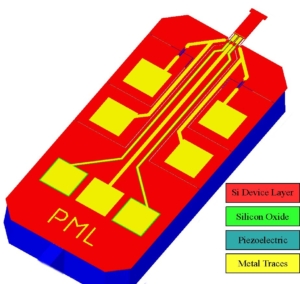 | M. G. Ruppert; Y. K. Yong Design of Hybrid Piezoelectric/Piezoresistive Cantilevers for Dynamic-mode Atomic Force Microscopy Proceedings Article In: IEEE/ASME Advanced Intelligent Mechatronics (AIM), Auckland, New Zealand, 2018, (This work was supported by the Australian Research Council Discovery Project DP170101813). Abstract | BibTeX | Tags: AFM, Cantilever, DP170101813, MEMS, Piezoelectric Transducers and Drives, Sensors, Smart Structures, SPM @inproceedings{Ruppert2018b,Atomic force microscope cantilevers with integrated actuation and sensing on the chip level provide several distinct advantages over conventional cantilever instrumentation. These include clean frequency responses, the possibility of down-scaling and parallelization to cantilever arrays as well as the absence of optical interferences. However, the two major difficulties with integrated transduction methods are a complicated fabrication process, often involving a number of fabrication steps, and a high amount of feedthrough from actuation to sensing electrodes. This work proposes two hybrid cantilever designs with piezoelectric actuators and piezoresistive sensors to reduce the actuator to sensor feedthrough. The designs can be realized using a commercial microelectromechanical systems fabrication process and only require a simple five-mask patterning and etching process. Finite element analysis results are presented to obtain modal responses, actuator gain and sensor sensitivities of the cantilever designs. |
| 9. | 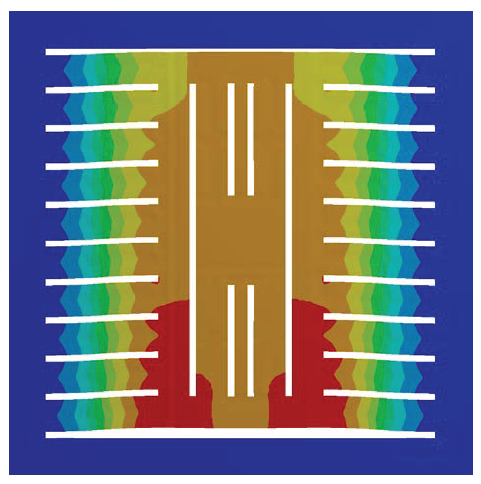 | S. I. Moore; M. Omidbeike; A. J. Fleming; Y. K. Yong A monolithic serial-kinematic nanopositioner with integrated sensors and actuators Proceedings Article In: IEEE International Conference on Advanced Intelligent Mechatronics, Auckland, New Zealand, 2018. Abstract | Links | BibTeX | Tags: AFM, Nanopositioning, SPM @inproceedings{C18e,This article describes the design, modeling and simulation of a serial-kinematic nanopositioner machined from a single sheet of piezoelectric material. In this class of nanopositioners, the flexures, sensors and actuators are completely integrated into a single monolithic structure. A non-trivial electrode topology is etched into the sheet to achieve in-plane bending and displacement of the moving platform. Finite element analysis predicts a sensitivity of 18.6 nm/V in the x-axis and 18.1 nm/V in the yaxis with a voltage limit of −250V to 1000 V. The first resonance frequency is 250 Hz in the Z axis. This design enables high-speed, long-range, lateral positioning in space-limited applications. |
| 8. |  | S. I. Moore; M. G. Ruppert; Y. K. Yong Arbitrary placement of AFM cantilever higher eigenmodes using structural optimization Proceedings Article In: International Conference on Manipulation, Automation and Robotics at Small Scales (MARSS), 2018, (This work was supported by the Australian Research Council Discovery Project DP170101813). Abstract | BibTeX | Tags: AFM, Cantilever, DP170101813, MEMS, Multifrequency AFM, Piezoelectric Transducers and Drives, Sensors, SPM, System Identification @inproceedings{Moore2018,This article presents a novel cantilever design approach to place higher mode frequencies within a specific frequency band to alleviate instrumentation and Q control feasibility. This work is motivated by the emerging field of multifrequency atomic force microscopy (AFM) which involves the excitation and/or detection of several cantilever modes at once. Unlike other operating modes, multifrequency AFM allows the tracking of the sample topography on the fundamental mode while simultaneously acquiring complimentary nanomechanical information on a higher mode. However, higher modes of conventional rectangular tapping-mode cantilevers are usually in the MHz regime and therefore impose severe restrictions on the direct controllability of these modes. To overcome this limitation, an optimization technique is employed which is capable of placing the first five modes within a 200 kHz bandwidth. |
| 7. | 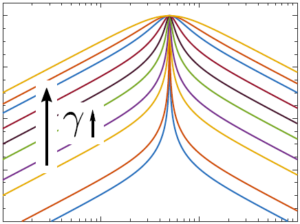 | M. G. Ruppert; D. M. Harcombe; S. I. Moore; A. J. Fleming Direct Design of Closed-loop Demodulators for Amplitude Modulation Atomic Force Microscopy Proceedings Article In: American Control Conference, Milwaukee, WI, 2018. Abstract | Links | BibTeX | Tags: AFM, SPM @inproceedings{C18b,A fundamental component of the z-axis feedback loop in amplitude modulation atomic force microscopy is the demodulator. It dictates both bandwidth and noise in the amplitude and phase estimate of the cantilever deflection signal. In this paper, we derive a linear time-invariant model of a closedloop demodulator with user definable tracking bandwidth and sensitivity to other frequency components. A direct demodulator design method is proposed based on the reformulation of the Lyapunov filter as a modulated-demodulated controller in closed loop with a unity plant. Simulation and experimental results for a higher order Lyapunov filter as well as Butterworth and Chebyshev type demodulators are presented. |
| 6. | 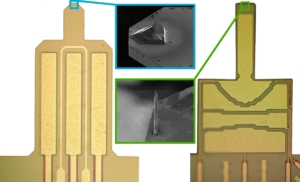 | M. G. Ruppert; S. I. Moore; M. Zawierta; G. Putrino; Y. K. Yong Advanced Sensing and Control with Active Cantilevers for Multimodal Atomic Force Microscopy Conference 7th Multifrequency AFM Conference, Madrid, Spain, 2018, (This work was supported by the Australian Research Council Discovery Project DP170101813). Abstract | BibTeX | Tags: AFM, Cantilever, DP170101813, MEMS, Multifrequency AFM, Sensors, Smart Structures, SPM, Vibration Control @conference{Ruppert2018,Atomic force microscopy (AFM) cantilevers with integrated actuation and sensing on the chip level provide several distinct advantages over conventional cantilever instrumentation. These include clean frequency responses, the possibility of down-scaling and parallelization to cantilever arrays as well as the absence of optical interferences. While cantilever microfabrication technology has continuously advanced over the years, the overall design has remained largely unchanged; a passive rectangular shaped cantilever design has been adopted as the industry wide standard. Consequently, conventional cantilever instrumentation requires external piezo acoustic excitation as well as an external optical deflection sensor. Both of these components are not optimal for current trends in multifrequency AFM technology which revolve around further down-sizing, parallelization and measurements at multiple higher eigenmodes. Using microelectromechanical systems (MEMS) fabrication processes, this work aims to optimize cantilever instrumentation by realizing a new class of probes with high-performance integrated actuators and sensors. Equipped with multiple integrated piezoelectric layers for both actuation and sensing, these cantilevers are capable of achieving an increased higher eigenmode sensitivity and/or guaranteed collocated system properties compared to commercially available counterparts; examples of such designs are shown in Figure 1. The geometry as well as the integrated actuator/sensor arrangement is optimized using finite element modelling with individual design goals. The designs are realized using a commercial MEMS fabrication process and only require a simple five-mask patterning and etching process and post-fabricated sharp tips. |
| 5. | 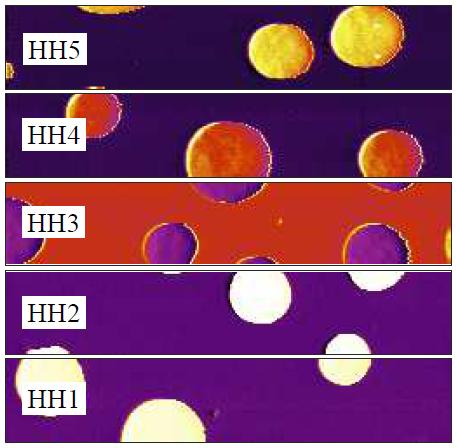 | D. M. Harcombe; M. G. Ruppert; M. R. P. Ragazzon; A. J. Fleming Lyapunov Estimation for High-Speed Demodulation in Multifrequency Atomic Force Microscopy Journal Article In: Beilstein Journal of Nanotechnology, vol. 9, pp. 490-498, 2018, ISSN: 21904286. Abstract | Links | BibTeX | Tags: AFM, Multifrequency AFM @article{J18c,An important issue in the emerging field of multifrequency atomic force microscopy (MF-AFM) is the accurate and fast demodulation of the cantilever-tip deflection signal. As this signal consists of multiple frequency components and noise processes, a lock-in amplifier is typically employed for its narrowband response. However, this demodulator suffers inherent bandwidth limitations as high frequency mixing products must be filtered out and several must be operated in parallel. Many MF-AFM methods require amplitude and phase demodulation at multiple frequencies of interest, enabling both z-axis feedback and phase contrast imaging to be achieved. This article proposes a model-based multifrequency Lyapunov filter implemented on a Field Programmable Gate Array (FPGA) for high-speed MF-AFM demodulation. System descriptions and simulations are verified by experimental results demonstrating high tracking bandwidths, strong off-mode rejection and minor sensitivity to cross-coupling effects. Additionally, a five-frequency system operating at 3.5MHz is implemented for higher harmonic amplitude and phase imaging up to 1MHz. |
2017 |
||
| 4. | 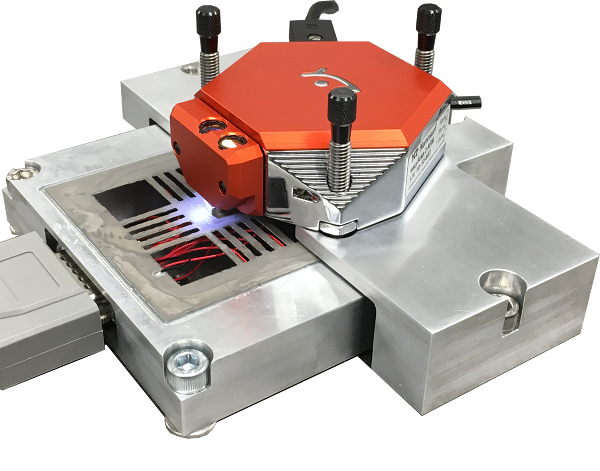 | A. J. Fleming; Y. K. Yong An Ultra-thin Monolithic XY Nanopositioning Stage Constructed from a Single Sheet of Piezoelectric Material Journal Article In: IEEE/ASME Transactions on Mechatronics, vol. 22, no. 6, pp. 2611-2618, 2017, ISBN: 1083-4435. Abstract | Links | BibTeX | Tags: AFM, Nanopositioning @article{J17k,The article describes an XY nanopositioning stage constructed from flexures and actuators machined into a single sheet of piezoelectric material. Ultrasonic machining is used to remove piezoelectric material and create electrode features. The constructed device is 0.508mm thick and has a travel range of 8.8um in the X and Y axes. The first resonance mode occurs at 597Hz which makes the device suitable for a wide range of standard nanopositioning applications where cost and size are considerations. Experimental atomic force microscopy is performed using the proposed device as a sample scanner. |
| 3. | 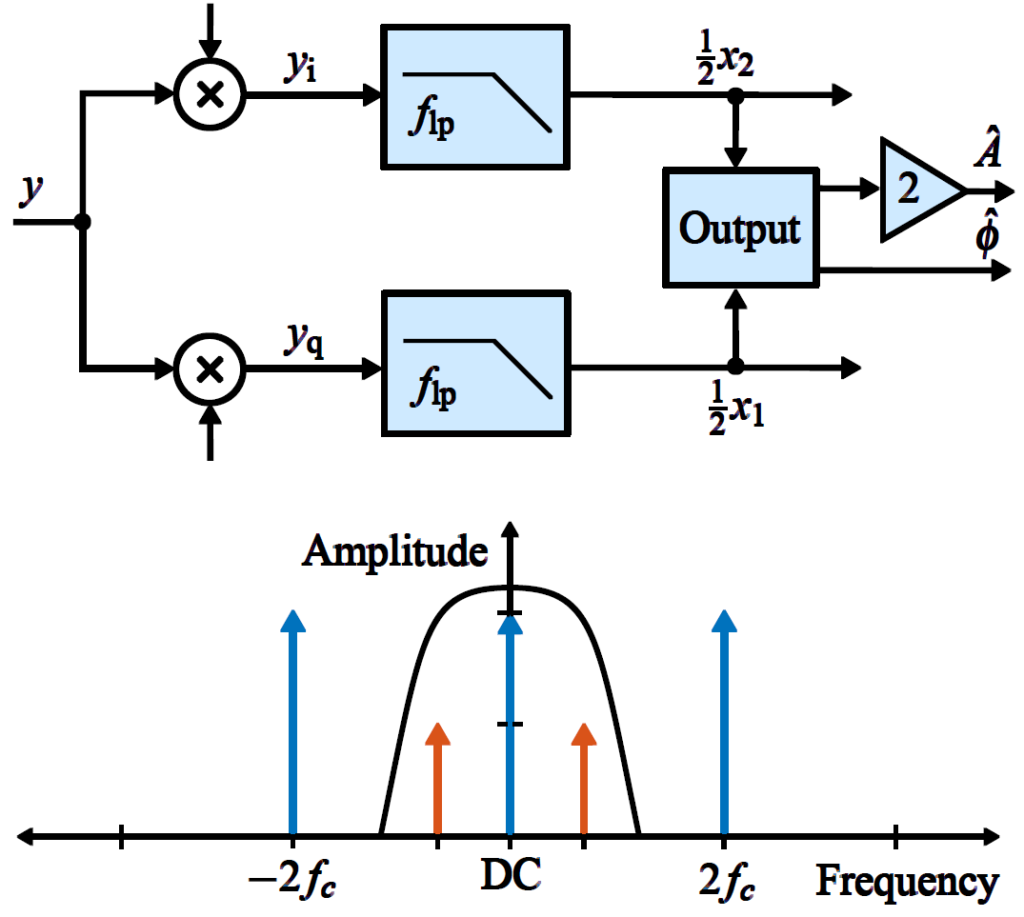 | M. G. Ruppert; D. M. Harcombe; M. R. P. Ragazzon; S. O. R. Moheimani; A. J. Fleming A Review of Demodulation Techniques for Amplitude Modulation Atomic Force Microscopy Journal Article In: Bellstein Journal of Nanotechnology, vol. 8, pp. 1407–1426, 2017. Abstract | Links | BibTeX | Tags: AFM, SPM @article{J17h,In this review paper, traditional and novel demodulation methods applicable to amplitude modulation atomic force microscopy are implemented on a widely used digital processing system. As a crucial bandwidth-limiting component in the z-axis feedback loop of an atomic force microscope, the purpose of the demodulator is to obtain estimates of amplitude and phase of the cantilever deflection signal in the presence of sensor noise or additional distinct frequency components. Specifically for modern multifrequency techniques, where higher harmonic and/or higher eigenmode contributions are present in the oscillation signal, the fidelity of the estimates obtained from some demodulation techniques is not guaranteed. To enable a rigorous comparison, the performance metrics tracking bandwidth, implementation complexity and sensitivity to other frequency components are experimentally evaluated for each method. Finally, the significance of an adequate demodulator bandwidth is highlighted during high-speed tapping-mode AFM experiments in constant height mode. |
| 2. | 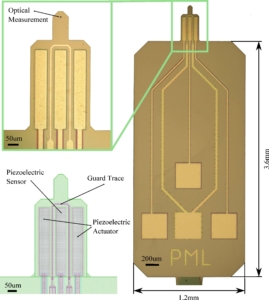 | M. G. Ruppert; Y. K. Yong Note: Guaranteed collocated multimode control of an atomic force microscope cantilever using on-chip piezoelectric actuation and sensing Journal Article In: Review of Scientific Instruments, vol. 88, no. 086109, 2017, (This work was supported by the Australian Research Council Discovery Project DP170101813). Abstract | Links | BibTeX | Tags: AFM, Cantilever, DP170101813, MEMS, Multifrequency AFM, Piezoelectric Transducers and Drives, System Identification, Vibration Control @article{Ruppert2017b,The quality (Q) factor is an important parameter of the resonance of the microcantilever as it determines both imaging bandwidth and force sensitivity. The ability to control the Q factor of multiple modes is believed to be of great benefit for atomic force microscopy techniques involving multiple eigenmodes. In this paper, we propose a novel cantilever design employing multiple piezoelectric transducers which are used for separated actuation and sensing, leading to guaranteed collocation of the first eight eigenmodes up to 3 MHz. The design minimizes the feedthrough usually observed with these systems by incorporating a guard trace on the cantilever chip. As a result, a multimode Q controller is demonstrated to be able to modify the quality factor of the first two eigenmodes over up to four orders of magnitude without sacrificing robust stability. |
| 1. | 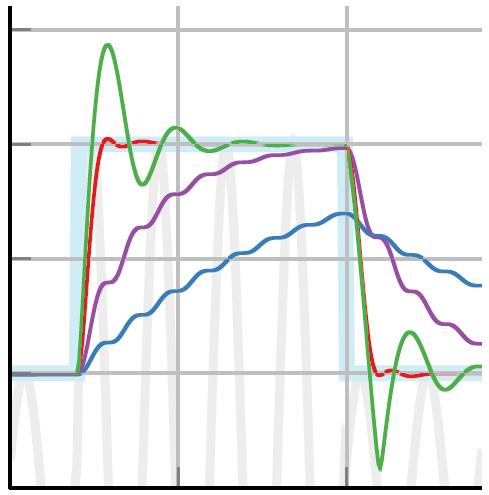 | M. R. P. Ragazzon; M. G. Ruppert; D. M. Harcombe; A. J. Fleming; J. T. Gravdahl Lyapunov Estimator for High-Speed Demodulation in Dynamic Mode Atomic Force Microscopy Journal Article In: IEEE Transactions on Control Systems Technology, vol. 26, no. 2, pp. 765-772, 2017. Abstract | Links | BibTeX | Tags: AFM, SPM @article{J17e,In dynamic mode atomic force microscopy (AFM), the imaging bandwidth is governed by the slowest component in the open-loop chain consisting of the vertical actuator, cantilever and demodulator. While the common demodulation method is to use a lock-in amplifier (LIA), its performance is ultimately bounded by the bandwidth of the post-mixing low-pass filters. This article proposes an amplitude and phase estimation method based on a strictly positive real Lyapunov design approach. The estimator is designed to be of low complexity while allowing for high bandwidth. Additionally, suitable gains for high performance are suggested such that no tuning is necessary. The Lyapunov estimator is experimentally implemented for amplitude demodulation and shown to surpass the LIA in terms of tracking bandwidth and noise performance. High-speed AFM images are presented to corroborate the results. |
2025 |
||
| 33. |  | Modulated-Illumination Intermittent-Contact Tip-Enhanced Raman Spectroscopy Journal Article In: ACS Nano Letters, 2025. |
2024 |
||
| 32. |  | Feasibility of gold nanocones for collocated tip-enhanced Raman spectroscopy and atomic force microscope imaging Journal Article Forthcoming In: Journal of Raman Spectroscopy, Forthcoming, ISSN: 1097-4555. |
2022 |
||
| 31. |  | In: Sensors and Actuators A: Physical, vol. 338, pp. 113496, 2022, ISSN: 0924-4247, (This work was supported by the Australian Research Council Discovery Project DP170101813). |
| 30. |  | Experimental Analysis of Tip Vibrations at Higher Eigenmodes of QPlus Sensors for Atomic Force Microscopy Journal Article In: Nanotechnology, vol. 33, iss. 18, pp. 185503, 2022, ISSN: 1361-6528, (This work was supported in part by the Australian Research Council Discovery Project DP170101813). |
2021 |
||
| 29. |  | Five-Axis Bimorph Monolithic Nanopositioning Stage: Design, Modeling, and Characterization Journal Article In: Sensors and Actuators A: Physical, vol. 332, iss. 1, 2021, ISSN: 0924-4247. |
| 28. |  | Characterization of Active Microcantilevers Using Laser Doppler Vibrometry Book Chapter In: Vibration Engineering for a Sustainable Future , Chapter 45, Springer, 2021, ISBN: 978-3-030-48153-7, (This work was supported by the Australian Research Council Discovery Project DP170101813). |
| 27. |  | Active atomic force microscope cantilevers with integrated device layer piezoresistive sensors Journal Article In: Sensors & Actuators: A. Physical, vol. 319, pp. 112519, 2021, ISSN: 0924-4247, (This work was supported by the Australian Research Council Discovery Project DP170101813). |
2020 |
||
| 26. |  | Integrated force and displacement sensing in active microcantilevers for off-resonance tapping mode atomic force microscopy Proceedings Article In: International Conference on Manipulation, Automation and Robotics at Small Scales (MARSS), pp. 1-6, 2020, (This work was supported by the Australian Research Council Discovery Project DP170101813). |
| 25. |  | A comparison of gold and silver nanocones and geometry optimisation for tip-enhanced microscopy Journal Article In: Journal of Raman Spectroscopy, vol. 51, iss. 11, pp. 2208-2216, 2020. |
| 24. |  | Traditional and Novel Demodulators for Multifrequency Atomic Force Microscopy Conference 8th Multifrequency AFM Conference, Madrid, Spain, 2020. |
| 23. |  | Overcoming the Limitations of Tip Enhanced Raman Spectroscopy with Intermittent Contact AFM Conference 8th Multifrequency AFM Conference, Madrid, Spain, 2020. |
| 22. |  | Amplitude Noise Spectrum of a Lock-in Amplifier: Application to Microcantilever Noise Measurements Journal Article In: Sensors and Actuators A: Physical, vol. 312, pp. 112092, 2020, (This work was supported by the Australian Research Council Discovery Project DP170101813). |
| 21. |  | AFM Cantilever Design for Multimode Q Control: Arbitrary Placement of Higher-Order Modes Journal Article In: IEEE/ASME Transactions on Mechatronics, pp. 1-6, 2020, (This work was supported by the Australian Research Council Discovery Project DP170101813). |
| 20. |  | A review of demodulation techniques for multifrequency atomic force microscopy Journal Article In: Beilstein Journal of Nanotechnology, vol. 11, pp. 76-97, 2020, ISSN: 21904286. |
2019 |
||
| 19. |  | Dynamics and Control of Active Microcantilevers Book Chapter In: Baillieul, John; Samad, Tariq (Ed.): Encyclopedia of Systems and Control, vol. 2, Springer London, 2019, ISBN: 978-1-4471-5102-9. |
| 18. |  | Scan Rate Adaptation for AFM Imaging Based on Performance Metric Optimisation Journal Article In: IEEE/ASME Transactions on Mechatronics, 2019, (early access). |
| 17. |  | Generalized Lyapunov Demodulator for Amplitude and Phase Estimation by the Internal Model Principle Proceedings Article In: 8th IFAC Symposium on Mechatronic Systems, 2019, (accepted for publication). |
| 16. | Resolution and Enhancement of Probes for Tip Enhanced Raman Spectroscopy Conference International Conference on Nanophotonics and Micro/Nano Optics (NANOP), Munich, Germany, 2019. | |
| 15. |  | An optimization framework for the design of piezoelectric AFM cantilevers Journal Article In: Precision Engineering, vol. 60, pp. 130-142, 2019, (This work was supported by the Australian Research Council Discovery Project DP170101813). |
| 14. |  | Modeling and Noise Analysis of a Microcantilever-based Mass Sensor Proceedings Article In: Int. Conference on Manipulation, Automation and Robotics at Small Scales (MARSS), Helsinki, Finland, 2019, ISSN: 978-1-7281-0948-0. |
| 13. |  | Model-based Q Factor Control for Photothermally Excited Microcantilevers Proceedings Article In: Int. Conference on Manipulation, Automation and Robotics at Small Scales (MARSS), Helsinki, Finland, 2019, ISSN: 978-1-7281-0948-0, (This work was supported by the Australian Research Council Discovery Project DP170101813). |
| 12. |  | Adaptive Scan for Atomic Force Microscopy Based on Online Optimisation: Theory and Experiment Journal Article In: IEEE Transactions on Control System Technology, 2019, (accepted for publication). |
| 11. |  | Multimodal atomic force microscopy with optimized higher eigenmode sensitivity using on-chip piezoelectric actuation and sensing Journal Article In: Nanotechnology, vol. 30, no. 8, pp. 085503, 2019, (This work was supported by the Australian Research Council Discovery Project DP170101813). |
2018 |
||
| 10. |  | Design of Hybrid Piezoelectric/Piezoresistive Cantilevers for Dynamic-mode Atomic Force Microscopy Proceedings Article In: IEEE/ASME Advanced Intelligent Mechatronics (AIM), Auckland, New Zealand, 2018, (This work was supported by the Australian Research Council Discovery Project DP170101813). |
| 9. |  | A monolithic serial-kinematic nanopositioner with integrated sensors and actuators Proceedings Article In: IEEE International Conference on Advanced Intelligent Mechatronics, Auckland, New Zealand, 2018. |
| 8. |  | Arbitrary placement of AFM cantilever higher eigenmodes using structural optimization Proceedings Article In: International Conference on Manipulation, Automation and Robotics at Small Scales (MARSS), 2018, (This work was supported by the Australian Research Council Discovery Project DP170101813). |
| 7. |  | Direct Design of Closed-loop Demodulators for Amplitude Modulation Atomic Force Microscopy Proceedings Article In: American Control Conference, Milwaukee, WI, 2018. |
| 6. |  | Advanced Sensing and Control with Active Cantilevers for Multimodal Atomic Force Microscopy Conference 7th Multifrequency AFM Conference, Madrid, Spain, 2018, (This work was supported by the Australian Research Council Discovery Project DP170101813). |
| 5. |  | Lyapunov Estimation for High-Speed Demodulation in Multifrequency Atomic Force Microscopy Journal Article In: Beilstein Journal of Nanotechnology, vol. 9, pp. 490-498, 2018, ISSN: 21904286. |
2017 |
||
| 4. |  | An Ultra-thin Monolithic XY Nanopositioning Stage Constructed from a Single Sheet of Piezoelectric Material Journal Article In: IEEE/ASME Transactions on Mechatronics, vol. 22, no. 6, pp. 2611-2618, 2017, ISBN: 1083-4435. |
| 3. |  | A Review of Demodulation Techniques for Amplitude Modulation Atomic Force Microscopy Journal Article In: Bellstein Journal of Nanotechnology, vol. 8, pp. 1407–1426, 2017. |
| 2. |  | Note: Guaranteed collocated multimode control of an atomic force microscope cantilever using on-chip piezoelectric actuation and sensing Journal Article In: Review of Scientific Instruments, vol. 88, no. 086109, 2017, (This work was supported by the Australian Research Council Discovery Project DP170101813). |
| 1. |  | Lyapunov Estimator for High-Speed Demodulation in Dynamic Mode Atomic Force Microscopy Journal Article In: IEEE Transactions on Control Systems Technology, vol. 26, no. 2, pp. 765-772, 2017. |
